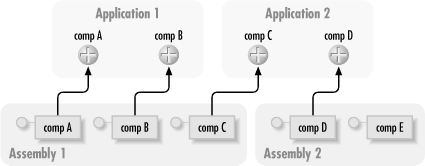.NET Assemblies and COM+ Applications
When you wish to take advantage of COM+ component services, you must map the assembly containing your serviced components to a COM+ application. That COM+ application then contains your serviced components, just like any other component—COM+ does not care whether the component it provides services to is a managed .NET serviced component or a classic COM, unmanaged, configured component. A COM+ application can contain components from multiple assemblies, and an assembly can contribute components to more than one application, as shown in Figure 10-1. Compare Figure 10-1 to Figure 1-8. There is an additional level of indirection in .NET because an assembly can contain multiple modules.

Figure 10-1. COM+ applications and assemblies
However, setting up an assembly to contribute components to more than one COM+ application is not straightforward and is susceptible to future registrations of the assembly. As a rule, avoid mapping an assembly to more than one COM+ application.
Get COM & .NET Component Services now with the O’Reilly learning platform.
O’Reilly members experience books, live events, courses curated by job role, and more from O’Reilly and nearly 200 top publishers.

